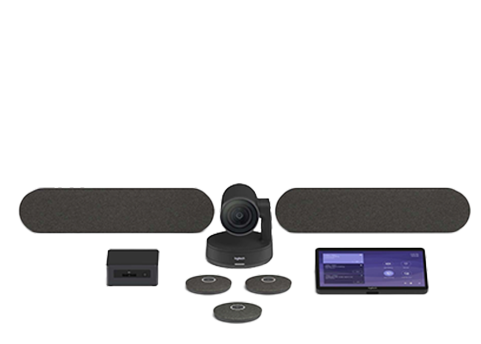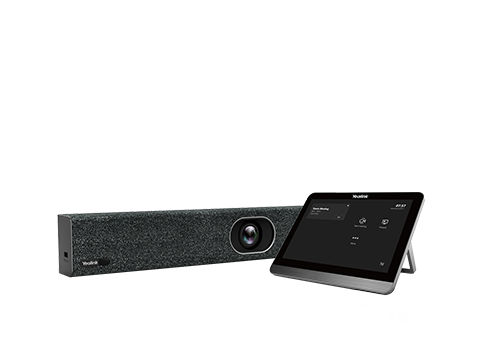Due to the events of the last two and a half years, by now we are all fully aware of Microsoft Teams and Zoom. With the easing of COVID restrictions around the globe, we are now seeing a number of clients seeking advice on what is the best equipment to install in their meeting spaces as the hybrid working model evolves.
BYOD, Webex, MTR-A, Zoom Rooms, Microsoft Teams Rooms, VMR, Google Hangouts Meet - what do all these mean and which is best for your company? Well that really depends on what your underlying platform is, how you collaborate and who you wish to meet with virtually. This article focuses on Microsoft Teams Rooms, but if you are unsure of which platform or device will work best for your organisation, feel free to reach out to one of our VC tech experts who will help guide you on this journey.
Microsoft Teams is a team collaboration software piece that comes with all Office 365 accounts.
A Microsoft Teams Room is the physical space that houses this software and the associated Audio Visual hardware required for an enhanced team collaboration setup.
Microsoft and its partners have developed integrated hardware and software solutions that are certified to address the performance needs in meeting rooms of different sizes and configurations.
For successful deployments that incorporate the right equipment for your meeting space, you must carefully evaluate the differences between the two options in question:
- Microsoft Teams Rooms on Windows (MTR-W)
- Microsoft Teams Rooms on Android (MTR-A)

Microsoft Teams Rooms on Windows
(MTR-W)
This option utilizes a dedicated Windows PC that remains in the meeting space at all times. The Teams Certified AV hardware that is installed in this room is paired with the PC - making the room a Certified Teams Room. Selecting the correct hardware and having it installed correctly ensures that the deployment meets Microsoft’s strict performance thresholds and the room functions as it should.

At the core of an MTR-W is a powerful mini-PC that forms the central hub of the system, handling and hosting the call. The user then chooses a camera and microphone to suit the size of the room. The principal difference from the MTR-A is that here you are running Microsoft Teams on a Windows PC rather than via an Android App.
Crestron and Poly have historically been the main players in this space, but due to the global chip shortage, we are seeing several other brands creep into the market in Australia. We have been busily testing these brands in our R&D facility over the past six months and are now happy to offer these to our customers and have stock available.

Microsoft Teams Rooms on Android
(MTR-A)
This option has a number of different names in the marketplace such as MTR-A, Video Bar, All-In-One, Smart Soundbar, etc. The main difference between MTR-W and MTR-A is that a MTR-A does not have a Windows PC, it uses an Android operating system that is housed in a sleek collaboration bar. This also houses the camera, speakers and microphones.

Historically MTR-W rooms have been rich in key features that the MTR-A rooms have lacked- such as dual screen mode, control interface, wireless sharing, etc. but we have seen this change dramatically in the past 12 months with the MTR-A devices now offering these features and many more.
There are a plethora of different choices in this space; Jabra, Logitech, Crestron, Poly, Neat, AVer, Yealink and Bose to name a few. Also, it is important to note that some devices are Teams Certified and others are not. We have tested a number of devices in our R&D facility and are able to demonstrate the key differences and make recommendations based on your particular needs. Due to the shortages we are seeing around the globe, we are also carrying stock of key devices to ensure the lead time issues some customers are experiencing are minimized.

Key Features
To help guide you as to what key features are available on each platform, you can refer to the linked chart which is updated periodically.
Final Thoughts
A Microsoft Teams Room on Android is generally less expensive to deploy than a Windows-based system and requires less initial and ongoing support from an IT team’s perspective. On the other hand, Windows-based Teams Rooms continue to have slightly more features available and are typically more suitable for larger, complex rooms than their Android counterpart.
We have seen in the past that updates and new features, such as dual screen support, are rolled out sooner on the Windows platform than on the Android version. However, the technology and the user experience are very similar in both room types.
There are a number of other factors that need to be considered when deploying effective video conferencing solutions for your staff, such as lighting, screen sizes, acoustics, room layouts, work-from-home solutions, etc. If you would like some help designing your next space, please feel free to reach out to one of our tech experts.



